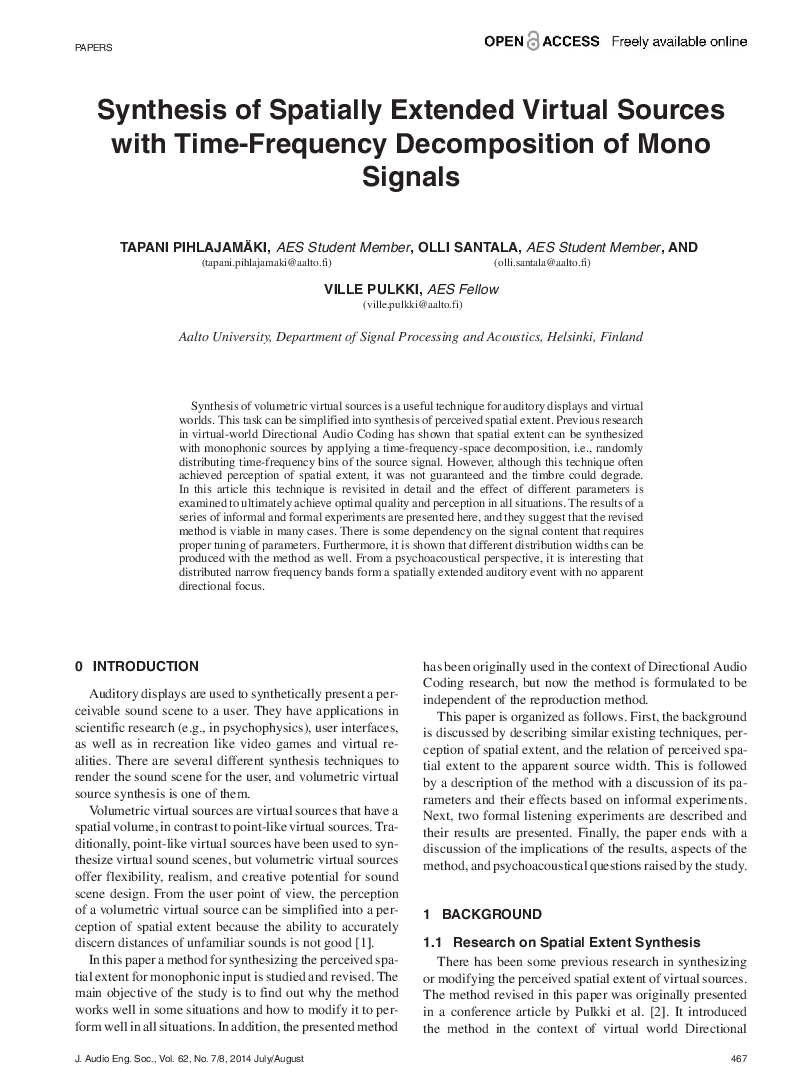Home / Publications / E-library page
You are currently logged in as an
Institutional Subscriber.
If you would like to logout,
please click on the button below.
Home / Publications / E-library page
Only AES members and Institutional Journal Subscribers can download
Auditory displays, driven by nonauditory data, are often used to present a sound scene to a listener. Typically, the sound field places sound objects at different locations, but the scene becomes aurally richer if the perceived sonic objects have a spatial extent (size), called volumetric virtual coding. Previous research in virtual-world Directional Audio Coding has shown that spatial extent can be synthesized from monophonic sources by applying a time-frequency-space decomposition, i.e., randomly distributing time-frequency bins of the source signal. This technique does not guarantee a stable size and the timbre can degrade. This study explores how to optimize volumetric coding in terms of timbral and spatial perception. The suggested approach for most types of audio uses an STFT window size of 1024 samples and then distributes the frequency bands from lowest to highest using the Halton sequence. The results from two formal listening experiments are presented.
Author (s): Pihlajamäki, Tapani; Santala, Olli; Pulkki, Ville
Affiliation:
Aalto University, Department of Signal Processing and Acoustics, Helsinki, Finland
(See document for exact affiliation information.)
Publication Date:
2014-07-06
Import into BibTeX
Permalink: https://aes2.org/publications/elibrary-page/?id=17339
(681KB)
Click to purchase paper as a non-member or login as an AES member. If your company or school subscribes to the E-Library then switch to the institutional version. If you are not an AES member Join the AES. If you need to check your member status, login to the Member Portal.

Pihlajamäki, Tapani; Santala, Olli; Pulkki, Ville; 2014; Synthesis of Spatially Extended Virtual Source with Time-Frequency Decomposition of Mono Signals [PDF]; Aalto University, Department of Signal Processing and Acoustics, Helsinki, Finland; Paper ; Available from: https://aes2.org/publications/elibrary-page/?id=17339
Pihlajamäki, Tapani; Santala, Olli; Pulkki, Ville; Synthesis of Spatially Extended Virtual Source with Time-Frequency Decomposition of Mono Signals [PDF]; Aalto University, Department of Signal Processing and Acoustics, Helsinki, Finland; Paper ; 2014 Available: https://aes2.org/publications/elibrary-page/?id=17339
@article{pihlajamäki2014synthesis,
author={pihlajamäki tapani and santala olli and pulkki ville},
journal={journal of the audio engineering society},
title={synthesis of spatially extended virtual source with time-frequency decomposition of mono signals},
year={2014},
volume={62},
issue={7/8},
pages={467-484},
month={july},}